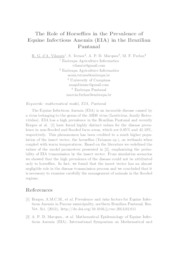The role of horseflies in the prevalence of Equine Infectious Anemia (EIA) in the Brazilian Pantanal.
The role of horseflies in the prevalence of Equine Infectious Anemia (EIA) in the Brazilian Pantanal.
Author(s): VILAMIU, R. G. d´A.; TERNES, S.; MARQUES, A. P. D.; FURLAN, M. F.
Summary: The Equine Infectious Anemia (EIA) is an incurable disease caused by a virus belonging to the genus of the AIDS virus (Lentivirus, family Retroviridae). EIA has a high prevalence in the Brazilian Pantanal and recently Borges at al. [1] have found highly distinct values for the disease prevalence in non-flooded and flooded farm areas, which are 0.85% and 42.10%, respectively. This phenomenon has been credited to a much higher population of the insect vector, the horseflies (Tabanus sp.), on wetlands when coupled with warm temperatures. Based on the literature we redefined the values of the model parameters presented in [2], emphasizing the probability of EIA transmission by the insect vector. From simulation scenarios we showed that the high prevalence of the disease could not be attributed only to horseflies. In fact, we found that the insect vector has an almost negligible role in the disease transmission process and we concluded that it is necessary to examine carefully the management of animals in the flooded regions.
Publication year: 2013
Types of publication: Abstract in annals or event proceedings
Observation
Some of Embrapa's publications are published as ePub files. To read them, use or download one of the following free software options to your computer or mobile device. Android: Google Play Books; IOS: iBooks; Windows and Linux: Calibre.
Access other publications
Access the Agricultural Research Database (BDPA) to consult Embrapa's full library collection and records.
Visit Embrapa Bookstore to purchase books and other publications sold by Embrapa.

